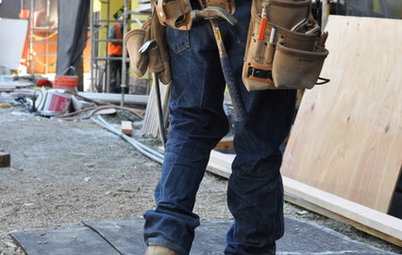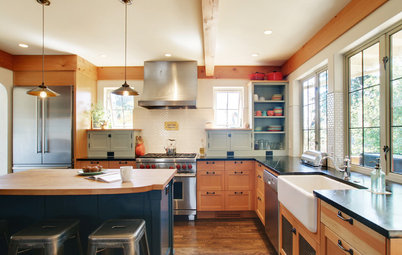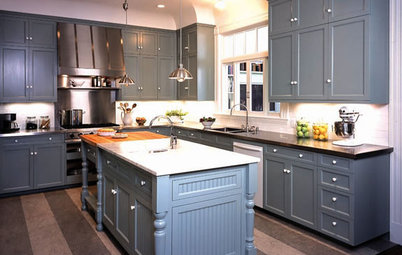Working With Pros
Remodeling Guides
Are You a Manager, Micromanager or Hands-Off Remodeler?
Discover the pros and cons of each homeowner style of working with design and remodeling pros
When you’re planning a remodel, there is plenty to think about. But one thing that might not be on your radar is your level of interaction with the process and, by extension, with the pros involved. How this plays out can impact everything from the length of time a project takes to your overall satisfaction with the work.
This guide will walk you through the pros and cons of three very different approaches to working with contractors and other pros — as a manager, a micromanager or a hands-off remodeler. Read on to learn about these styles, and then tell us in the Comments which approach has worked best for you.
This guide will walk you through the pros and cons of three very different approaches to working with contractors and other pros — as a manager, a micromanager or a hands-off remodeler. Read on to learn about these styles, and then tell us in the Comments which approach has worked best for you.
Drawbacks to being the manager. There’s a difference between holding up your end of the responsibilities and simply jumping in and trying to take over. Jumping in frequently to check in on how things are progressing can be perceived by your contractor as overstepping. Stepping in too frequently also can disrupt work and create more confusion than it resolves.
Takeaway: Clearly define your official role. Are you hiring a project manager? This could be your general contractor, a designer or an architect. If you are, it’s important to recognize that you are actually paying this person to handle the management of your team and project. If not, you are by necessity taking on the role of project manager — a very different scenario! In the (more common) case, in which you have hired a project manager, it’s important to clearly define where your role ends and your contractor’s or designer’s role begins. It can help to sit down with your contractor before work begins to go over exactly what each party will be responsible for, and where those responsibilities might overlap.
Takeaway: Clearly define your official role. Are you hiring a project manager? This could be your general contractor, a designer or an architect. If you are, it’s important to recognize that you are actually paying this person to handle the management of your team and project. If not, you are by necessity taking on the role of project manager — a very different scenario! In the (more common) case, in which you have hired a project manager, it’s important to clearly define where your role ends and your contractor’s or designer’s role begins. It can help to sit down with your contractor before work begins to go over exactly what each party will be responsible for, and where those responsibilities might overlap.
2. The Micromanager
Why being a micromanager can be a good thing: Micromanagers get a bad rap, but there is an upside to this management style: Micromanagers tend to be detail-oriented, proactive and good on a deadline. This can be a real help when it comes to those hundreds (maybe thousands?) of decisions that must be made during a remodel. Where others may collapse from the pressure, a micromanager will likely thrive.
Drawbacks of micromanaging: Becoming overly involved in your home project — to the point that you are trying to control every tiny detail — can slow down or stall work, create frustration on the part of the pros you have hired and ultimately make for a not-very-pleasant working experience. Are there times when it pays to micromanage? Certainly, and we’ll look at those next. But keep it up and you will exhaust everyone … including yourself!
Why being a micromanager can be a good thing: Micromanagers get a bad rap, but there is an upside to this management style: Micromanagers tend to be detail-oriented, proactive and good on a deadline. This can be a real help when it comes to those hundreds (maybe thousands?) of decisions that must be made during a remodel. Where others may collapse from the pressure, a micromanager will likely thrive.
Drawbacks of micromanaging: Becoming overly involved in your home project — to the point that you are trying to control every tiny detail — can slow down or stall work, create frustration on the part of the pros you have hired and ultimately make for a not-very-pleasant working experience. Are there times when it pays to micromanage? Certainly, and we’ll look at those next. But keep it up and you will exhaust everyone … including yourself!
Takeaway: Know what level of communication is reasonable. If you and your contractor have a mismatch in expectations when it comes to communications, you may feel ignored while from the contractor’s perspective, things are running smoothly and all is normal! As a general rule, it’s not unreasonable to have a phone call returned within a day, and an email (especially if you’re asking lots of things) within several days. If you know you’re tempted to call or email your pro very frequently, it might be helpful to keep a running list of questions and concerns instead, and then set a regular day or time to check in when you can get all of your concerns heard and responded to at once.
A Beginner’s Guide to Managing a Remodel
A Beginner’s Guide to Managing a Remodel
Takeaway: Name your top priorities and let the rest go. It’s easy in the middle of a big project to become so focused on details that every single thing seems to have equal weight. As much as we would all (your pros included) love for every single tiny detail of a project to turn out perfect, the reality is that’s not very likely. Some things won’t be possible, mistakes will be made, pieces will go out of stock, problems will arise. That’s the nature of the beast.
So what can you do? Figure out what is really important to you (hint: The answer can’t be “everything”) and keep a list of these top priorities with you. Where those specific things are involved, feel free to be a little more hands-on. Need to make sure the contractor doesn’t forget you specified dark grout around the kitchen tiles? Go ahead and call with a reminder. But if the issue at hand hasn’t made your top-priority list, take some deep breaths and let it go.
Houzz Quiz: What Kind of Remodeling Client Are You?
So what can you do? Figure out what is really important to you (hint: The answer can’t be “everything”) and keep a list of these top priorities with you. Where those specific things are involved, feel free to be a little more hands-on. Need to make sure the contractor doesn’t forget you specified dark grout around the kitchen tiles? Go ahead and call with a reminder. But if the issue at hand hasn’t made your top-priority list, take some deep breaths and let it go.
Houzz Quiz: What Kind of Remodeling Client Are You?
3. The Hands-Off Remodeler
Why being hands-off during your remodel can be a good thing. What pro wouldn’t want to work with a laid-back remodeling client? When you take a hands-off approach, you are putting your faith in your team members to do their best work. Hands-off remodelers exude patience and calm, both key qualities in any successful remodel. You may even be physically removed from the site, which can potentially help speed things along, if workers don’t need to work around your schedule or worry about kids and pets underfoot.
Drawbacks of being hands-off. Being a completely hands-off remodeling client sounds good on paper, and it can work out really well. But as the homeowner, you know your home, neighbors, property and (most important) what you want to get out of this project — and to that extent, it makes a lot of sense for you to be involved in some capacity. At its worst, “hands-off” can translate into “indecisive” or “apathetic.” If you’re not able to decide promptly about things, or your pro has trouble reaching you, that can spell delays for your project.
Why being hands-off during your remodel can be a good thing. What pro wouldn’t want to work with a laid-back remodeling client? When you take a hands-off approach, you are putting your faith in your team members to do their best work. Hands-off remodelers exude patience and calm, both key qualities in any successful remodel. You may even be physically removed from the site, which can potentially help speed things along, if workers don’t need to work around your schedule or worry about kids and pets underfoot.
Drawbacks of being hands-off. Being a completely hands-off remodeling client sounds good on paper, and it can work out really well. But as the homeowner, you know your home, neighbors, property and (most important) what you want to get out of this project — and to that extent, it makes a lot of sense for you to be involved in some capacity. At its worst, “hands-off” can translate into “indecisive” or “apathetic.” If you’re not able to decide promptly about things, or your pro has trouble reaching you, that can spell delays for your project.
Takeaway: Make your voice heard during the planning stage. The planning stage is when it’s the most helpful to really pay attention, ask lots of questions and be an active participant in the process. If, for instance, you know you’re planning to live off-site while the work is being done, and won’t be as available for day-to-day decision-making, it’s extra important to get your voice heard early on. And of course, this is solid advice for anyone, not just hands-off remodelers!
Takeaway: Set up a regular schedule to check in with your team. For the hands-off remodeler, it can be all too easy to let things roll along without checking in, only to realize too late that something is amiss. To avoid late-in-the game errors that are difficult and costly to fix, it’s smart to set up a regular schedule to check in with your contractor. Be organized and keep all of the paperwork associated with your remodel in one place, and have this with you when you speak with your contractor.
Homeowners: Which approach has worked best for you in the past? Tell us in the Comments.
Pros: Which homeowner remodeling style have you found most productive? Share your thoughts in the Comments.
More on Houzz
Read more remodeling guides
Get design ideas
Find a pro
Shop for products
Homeowners: Which approach has worked best for you in the past? Tell us in the Comments.
Pros: Which homeowner remodeling style have you found most productive? Share your thoughts in the Comments.
More on Houzz
Read more remodeling guides
Get design ideas
Find a pro
Shop for products

























Why being a manager can be a good thing. In a sense, as the homeowner, you are the overall manager, no matter what the project is. It’s your money and on your property where the work is happening. Even if you have an official project manager (and for nearly any remodeling project, that’s a very good idea), there is still room for you as the homeowner to act as a sort of big-picture manager. Taking care to keep good records, track your finances and generally have a healthy sense of where things are going is part of being a responsible manager. A good manager doesn’t hide from potential challenges, communicates clearly and effectively, and voices concerns rather than letting things fester.
Find a remodeling professional on Houzz